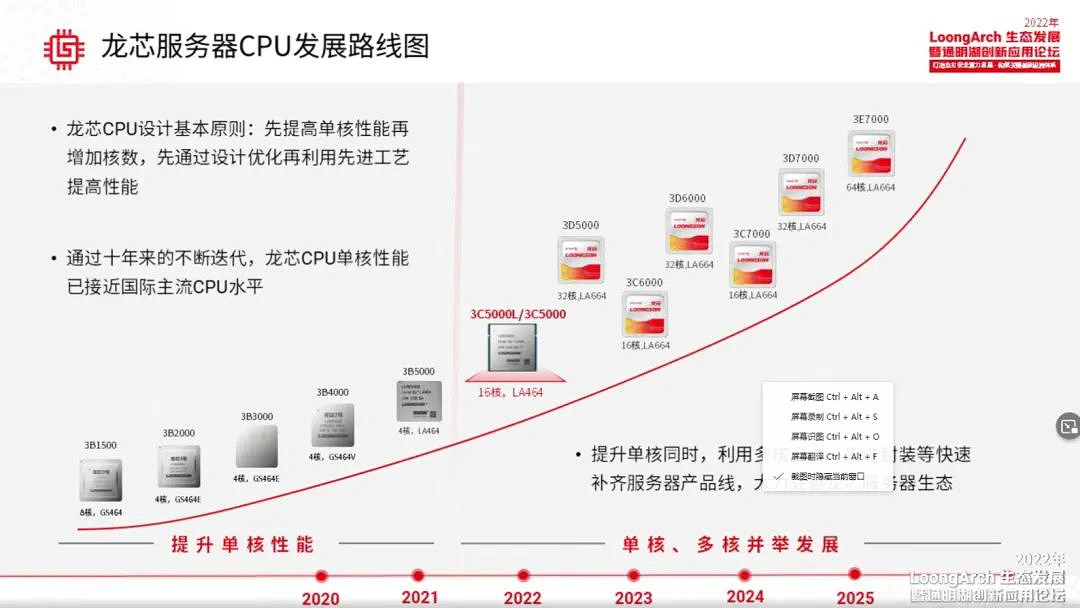Chinese Loongson Claims Next-Gen CPU Matches AMD's Zen 3
Based on simulations.
Having launched its first 16-core CPU for servers earlier this week, Loongson is looking forward to releasing a 32-core processor in the coming months and matching the performance of AMD's Zen 3-based products in the coming years.
Chinese CPU developer Loongson formally introduced and started to ship its first 16-core 3C5000 processor based on its proprietary LoongArch instruction set architecture earlier this week. At a conference where the CPU was officially unveiled, the company also talked about its future endeavors, and they look pretty ambitious. In the coming months, the company will reveal its 3D5000 CPU with 32 cores, which will combine two 3C5000 processors on a single piece of substrate. In contrast, its next-generation 6000-series processors may match the instruction per cycle (IPC) performance of AMD's Zen 3 microarchitecture, reports EET-China.
Loongson's current-generation 5000-series (quad-core 3A5000 and 16-core 3C5000/3C5000L) processors are on its LoongArch-based 64-bit superscalar LA464 cores. They are compatible with the MIPS ISA (to maintain compatibility with applications written for Loongson's previous-generation processors) but can also execute code explicitly written for LoongArch. With four general-purpose ALUs, and two 256-bit vector operations units, the LA464 cores look promising. Still, once the software is recompiled to take advantage of 2,000 proprietary LoongArch instructions, they promise to shine.
Based on the numbers demonstrated by Loongson at its conference, Loongson claims the quad-core 3A5000 processor operating at 2.50 GHz can challenge popular eight-core Armv8 implementations as well as Intel's 10th Generation Core 'Comet Lake' processors in terms of single-thread performance in UnixBench. However, the chip falls behind in multi-thread execution speed for obvious reasons. Meanwhile, Loongson did not publish the performance of its 16-core 3C5000 CPU in a similar scenario but only mentioned that the processor operates at 2.0–2.2 GHz and delivers up to 560 GFLOPS of raw performance at 130W.
For its next-generation Loongson 6000-series processors, the company plans to use its upcoming LA664 core design to increase efficiency and boost IPC throughput, the company said at its event, citing the results of its simulations. As a result, Loongson's 16-core 3C6000 and 32-core 3D6000 processors due in 2023~2024 will supposedly be able to challenge AMD's Ryzen and EPYC CPUs based on the Zen 3 microarchitecture in terms of performance per cycle. (Yes, that's an architecture from 2020, but the company has to start somewhere.)
For Loongson, matching AMD Zen 3's IPC in 2023 is a big deal since the company will be somewhat able to close the gap with modern chips from leading developers. Still, matching instructions per cycle alone may not be enough to reach the actual performance of AMD's CPUs. AMD's Zen 3 chips can clock in the 4.5–4.7 GHz range, which is significantly higher than the 2.5 GHz clocks Loongson has mentioned.
Perhaps Loongson's 16-core 3C6000 and 32-core 3D6000 processors will be able to challenge the real-world performance of AMD's contemporary low-power EPYC processors in programs that can take advantage of LoongArch's innovations. Still, we would not expect Loongson's 2023 offerings to be competitive against AMD's 2021 CPUs.
Interestingly, due to its 16-core 3C7000, 32-core 3D7000, and 64-core 3E7000 processors due in 2024~2025, Loongson will continue to rely on its LA664 core design, though it will probably produce them on a new node to increase their performance per watt efficiency.
Up to 64 cores and improved performance per watt might pose a more significant challenge to CPUs from AMD and Intel, but expecting Loongson's products to replace processors from leading designers in performance-demanding applications is too optimistic.
Get Tom's Hardware's best news and in-depth reviews, straight to your inbox.

Anton Shilov is a contributing writer at Tom’s Hardware. Over the past couple of decades, he has covered everything from CPUs and GPUs to supercomputers and from modern process technologies and latest fab tools to high-tech industry trends.
-
SkyBill40 ReplyKridian said:I need one of those with the CCP malware built in.
Just buy it... comrade. -
punkncat So, last year they release a chip as good as Ryzen 1. This time, a year and some later, as good as Ryzen 3. That is some impressive innovation if they really are using their own proprietary design.Reply
Does anyone have any idea what the price on these ballparks? -
hasten Are they using the 3C5000 to perform the simulations?Reply
They have released no such chip. Its on their roadmap and their internal simulations have it matching zen 3. So not really impressive at all.punkncat said:So, last year they release a chip as good as Ryzen 1. This time, a year and some later, as good as Ryzen 3. That is some impressive innovation if they really are using their own proprietary design.
Does anyone have any idea what the price on these ballparks? -
gg83 I wonder if they have to promise such high performance to ensure future funding from the government. Startups do it all the time, right?. 1 out of 10 actually deliver. Probably lessReply -
blargh4 Replyhasten said:Are they using the 3C5000 to perform the simulations?
They have released no such chip. Its on their roadmap and their internal simulations have it matching zen 3. So not really impressive at all.
The goal here is presumably Chinese technological independence from the sanctions-happy west rather than going toe-to-toe with AMD on geekbench. Though I'd think domestic advanced semiconductor nodes would be a bigger impediment there than uarch. Desktop CPUs are basically a solved problem and its a matter of no-time-at-all until China is on par.

